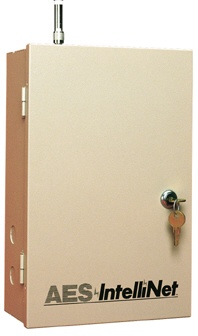 In 1976, under contract by the US Government, AES Corporation began developing products for specialized security applications. This expanded to also providing security installation and design services to US Government facilities throughout the world. In 1976, under contract by the US Government, AES Corporation began developing products for specialized security applications. This expanded to also providing security installation and design services to US Government facilities throughout the world.
In the early 1990s, AES Corp. responded to a U.S. Government request to develop a wireless communications network that would serve the security communications needs of Americans in remote and often hostile parts of the world. The challenge was to create a 2-way data network that required no dedicated radio towers, no reliance on local phone or cellular providers, was highly reliable, and easy to install and manage.
As a result, AES Corp. developed and patented the first long-range wireless mesh network, known as AES-IntelliNet. AES-IntelliNet technology has delivered highly reliable wireless mesh networks to the fire alarm and burglary/intrusion market.
Wireless mesh networking is an innovative technology for applications that need to communicate data over a large geographic area with a high level of reliability. The AES wireless mesh technology eliminates the need for GSM/GPRS or tower-based private radio fees, phone lines, cabling or trenching making it easy to install and manage at a price level far superior to traditional communications methods, both wired and wireless. Network users can gain significant revenue, communications and cost advantages while meeting the high standards of the life safety industry. AES-IntelliNet systems are used in hundreds of thousands locations in over 55 countries worldwide.
How It Works
AES-IntelliNets wireless mesh network utilizes the following principles:
?Each subscriber connected to an alarm panel or FACP self enrolls into network.
?Geographic expansion is accomplished by installing additional subscribers.
?If subscriber unit is too far from central station it will simply pass the information to the next subscriber in the network and hop the data to the central station.
?Each subscriber unit is capable of developing dual-redundant paths of communications back to the central station.
?The network dynamically and automatically adapts to changes in the network to maintain a high degree of redundancy and integrity.
?Minimal RF installation experience required to install.
Geographically Separated Networks
Wireless mesh networks operate very well in areas where there is a relative density of remote transceivers to form the network.
?Geographic boundaries are now just lines on a map.
?AES-IntelliNet networks can now transmit alarm data anywhere in the world. Utilizing the RF signaling from the protected premise to a secure IP Link the new RF-to-Internet network delivers alarm signals anywhere in the world.
?The IP Link receives the wireless data, converts it to TCP/IP and relays it over the Internet to the Central Receiver for processing at the central station.
?Used heavily by commercial, government and residential companies such as alarm monitoring companies, corporations, university campuses, municipalities, military and government entities.
● Wireless Mesh Benefits
?Cost : No monthly fee vs. celluar & telephone communications services
?Reliability : Multi-communication paths, not prone to line cuts
?Speed of transmission : 10 times faster than telephone dialed communications
For more info., contact to email swm@infothe.com
ⓒ2007 www.SecurityWorldmag.com. All rights reserved. |



